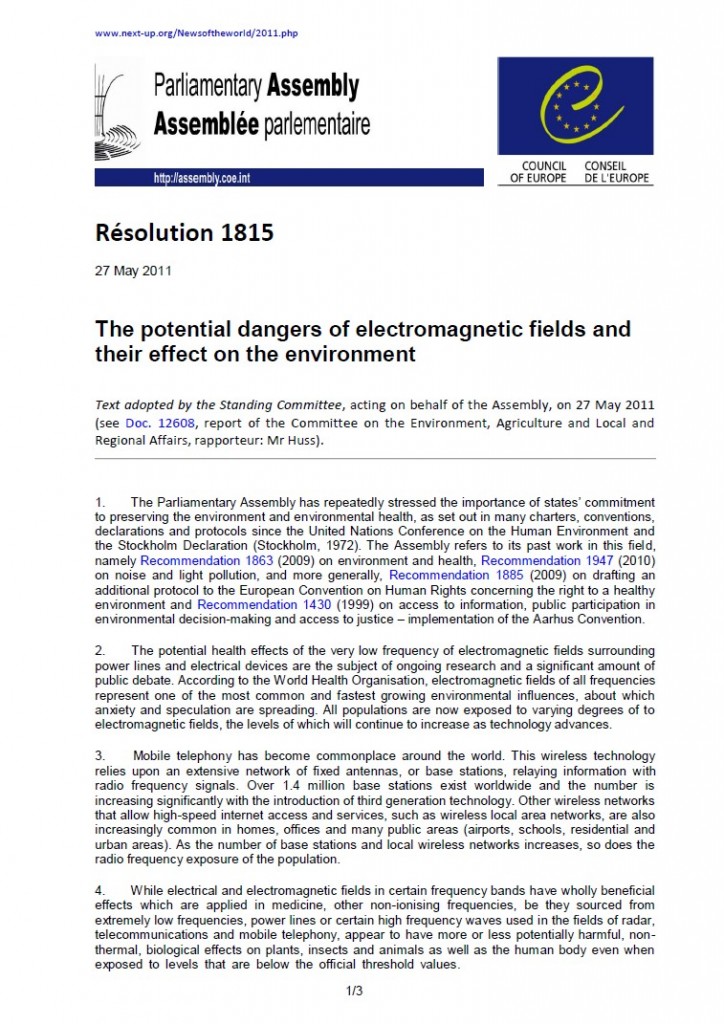Portada del sitio > Fauna > Universidad de Zurich: nuclear cataract in calves by cellular telefone (...)

Universidad de Zurich: nuclear cataract in calves by cellular telefone antenna in Switzerland
"First results show a connection between location of the cataract calves in the Third of the pregnantness and the transmitting power of the next mobile phone base station, as well as the total transmitting power of all surrounding antennas."
Sábado 5 de mayo de 2007 · 6872 lecturas
Nuclear cataract in calves by cellular telefone antenna in Switzerland
"First results show a connection between location of the cataract calves in the Third of the pregnantness and the transmitting power of the next mobile phone base station, as well as the total transmitting power of all surrounding antennas."
Nuclear cataract in calves by cellular telephones antenna in Switzerland
Original title / original titles
Nuclear cataract with newborn calves which near Handy-Antennen is held
automatic traslation
Summary / summary
It is the goal of the present study, the prevalence of nuclear cataracts in battle calves in Switzerland too evaluieren.
Nuclear cataracts with calves originate mainly in the first two third of the pregnancy, in the time of the embryonic development of the lentil. 81 became in this study with 253 by chance selected calves of both sex, 32 percent) found nuclear cataracts in different shaping. The calves were examined Kowa SL5 ophthalmoscopic after the Schlachtung with a slit lamp of the type shortly, as well as aqueous humor and skin biopsies taken. At the time of the rogatory walk, all calves were between 3 and 6 months old. 9 out of 253, 3,6 percent) calves had 5,1 percent a strongly particular cataract with completely clouded lentil, 13,) calves one of middle-exactly-y clouded lentil and 25, 9,9 percent) calves a centrally in the lentil incipient, little particular cataract. With 15, 5,9 percent) calves became cataract one in the post Rio reindeer nucleus edge, with 2, found 0.8 percent) calves was clouded the whole rear nucleus half. 11, 4,4 percent) calves showed compacted nucleus edges, during 6, 2,4 percent) calves miscellaneous focal cloudings of the lenticular nucleus showed.
It could not be proved to any race-dependent cataract habit. However was more male calves significantly concerned.
BVDV as knownest infectious cause for cataract with the cow could be excluded by means of immune histology from skin biopsies. As well, no antibodies were proved against Neospora and toxoplasma in the aqueous humor.
Between the age of the mothers and the likelihood of the Kataraktogenese with calves, no statistical connections could be found. At present, genetic connections are examined by means of family tree analyses of the concerned calves in cooperation with the breeding associations.
The aqueous humor tests of cataract-eyelets eyes showed Glutathionperoxidase a significant degraded activity of the enzyme which lets locked into the eye on elevated oxidative stress. The activity of the enzyme catalase was statistically tendencially degraded, no changes showed those of the peroxide dismutase. In accordance with literature, there is the suspicion that radiation of mobile radio antennas in the eye can cause oxidative stress. Definitely, the coordinates of all locations of a calf, from the insemination time of the dam as far as to the Schlachtung of the calf, could become on the basis of the earmark. Also coordinates and locations of the surrounding Handyantennen were grasped and for were looked connections. First results show a connection between location of the cataract calves in the 1. Third of the pregnancy and the Sendeleistung of the next-standing mobile radio antenna, as well as the total end performance of all surrounding antennas. These results must still be checked for Evidenz.
Keywords / search concept
bovine, calf, antenna, handy, cellular, nuclear cataract
Original title / OriginaltitelNukleärer Katarakt bei neugeborenen Kälbern welche in der Nähe von Handy-Antennen gehalten werdenSummary / ZusammenfassungDas Ziel der vorliegenden Studie ist es, die Prävalenz von nukleären Katarakten bei Schlachtkälbern in der Schweiz zu evaluieren.
Nukleäre Katarakte bei Kälbern entstehen hauptsächlich in den ersten beiden Dritteln der Trächtigkeit, in der Zeit der embryonalen Entwicklung der Linse. In dieser Studie wurden bei 253 zufällig ausgesuchten Kälbern beiden Geschlechtes 81 (32%) nukleäre Katarakte in verschiedener Ausprägung gefunden. Die Kälber wurden kurz nach der Schlachtung mit einer Spaltlampe des Typs Kowa SL5 ophthalmoskopisch untersucht, sowie Kammerwasser- und Hautbiopsien entnommen. Zum Zeitpunkt des Untersuchungsganges waren alle Kälber zwischen 3 und 6 Monate alt. 9 von 253 (3,6%) Kälber hatten eine stark ausgeprägte Katarakt mit vollständig getrübter Linse, 13 (5,1%) Kälber eine mittelgradig getrübte Linse und 25 (9,9%) Kälber eine zentral in der Linse beginnende, wenig ausgeprägte Katarakt. Bei 15 (5,9%) Kälbern wurde eine Katarakt im posterioren Nukleusrand gefunden, bei 2 (0.8%) Kälbern war die ganze hintere Nukleushälfte getrübt. 11 (4,4%) Kälber zeigten verdichtete Nukleusränder, während 6 (2,4%) Kälber diverse fokale Trübungen des lentikulären Nukleus aufwiesen.
Es konnte keine rasseabhängige Kataraktprädisposition nachgewiesen werden. Jedoch waren signifikant mehr männliche Kälber betroffen.
BVDV als bekannteste infektiöse Ursache für Katarakt beim Rind konnte mittels Immunhistologie aus Hautbiopsien ausgeschlossen werden. Ebenso wurden keine Antikörper gegen Neospora und Toxoplasma im Kammerwasser nachgewiesen.
Zwischen dem Alter der Mütter und der Wahrscheinlichkeit der Kataraktogenese bei Kälbern konnten keine statistischen Zusammenhänge gefunden werden. Derzeit werden in Zusammenarbeit mit den Zuchtverbänden mittels Stammbaumanalysen der betroffenen Kälber genetische Zusammenhänge untersucht.
Die Kammerwasserproben von kataraktösen Augen wiesen eine signifikante erniedrigte Aktivität des Enzyms Glutathionperoxidase auf, was auf erhöhten oxidativen Stress im Auge schliessen lässt. Die Aktivität des Enzyms Katalase war statistisch tendenziell erniedrigt, jene der Superoxiddismutase wies keine Veränderungen auf. Gemäss Literatur besteht der Verdacht, dass Strahlung von Mobilfunkantennen im Auge oxidativen Stress auslösen kann. Aufgrund der Ohrmarke konnten die Koordinaten sämtlicher Standorte eines Kalbes, vom Besamungszeitpunkt des Muttertiers bis zur Schlachtung des Kalbes, bestimmt werden. Auch wurden Koordinaten und Standorte der umliegenden Handyantennen erfasst und Zusammenhänge gesucht. Erste Resultate zeigen einen Zusammenhang zwischen Standort der Kataraktkälber im 1. Drittel der Trächtigkeit und der Sendeleistung der nächststehenden Mobilfunkantenne, sowie der Gesamtsendeleistung aller umliegenden Antennen. Diese Resultate müssen noch auf Evidenz überprüft werden.Keywords / Suchbegriffebovine, calf, antenna, handy, cellular, nuclear cataractProject Leadership and Contacts /
Projektleitung und KontakteProf. Berhard Spiess (Project Leader) Prof. Hanspeter Nägeli PD Dr. Michael Hässig (Project Leader) Funding Source(s) /
Unterstützt durchForschungskredit der Universität Zürich, Others
Ver el artículo original AQUÍ







